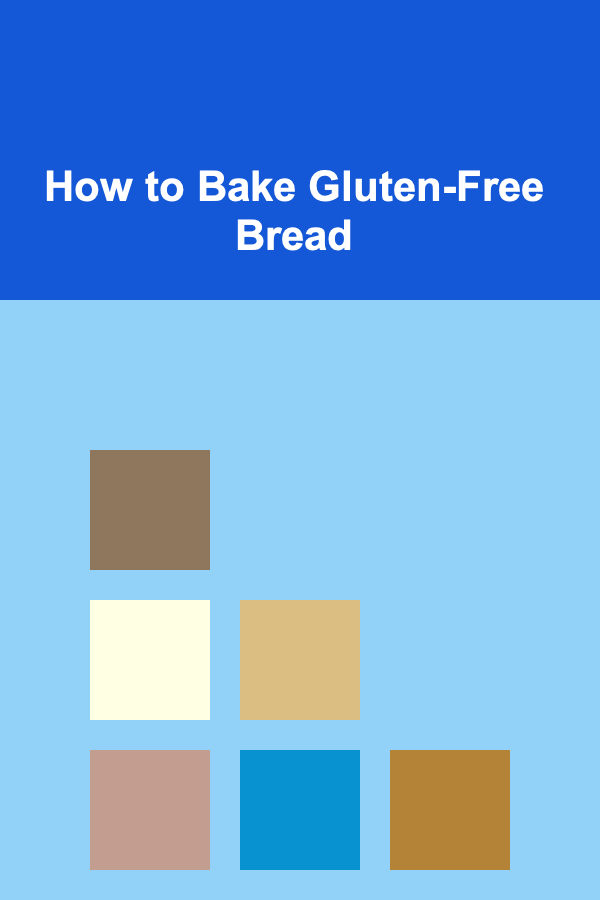
How to Bake Gluten-Free Bread
ebook include PDF & Audio bundle (Micro Guide)
$12.99$8.99
Limited Time Offer! Order within the next:

Baking gluten-free bread can be a rewarding and delicious experience. Whether you're following a gluten-free diet due to celiac disease, gluten sensitivity, or simply because you want to try something different, baking gluten-free bread at home allows you to enjoy freshly baked loaves that meet your dietary needs without compromising on taste or texture. However, gluten-free baking presents its own unique set of challenges, particularly when it comes to achieving the perfect texture, rise, and flavor. In this article, we will explore the basics of gluten-free bread baking, provide tips and tricks for success, and guide you through the entire process.
What is Gluten-Free Bread?
Gluten-free bread is bread made without gluten, a protein found in wheat, barley, and rye. Gluten gives bread its elasticity and structure, allowing it to rise and hold its shape. Without gluten, bread dough lacks the structure that traditional bread gets from wheat flour. As a result, gluten-free bread requires the use of alternative flours and binding agents to mimic the texture and structure of traditional bread.
While gluten-free bread can be made using a variety of different ingredients, the key challenge is to achieve a bread that is soft, light, and moist, with a good crumb structure, without relying on gluten. This requires a mix of gluten-free flours, starches, fats, liquids, and binding agents, as well as careful baking techniques.
Key Ingredients in Gluten-Free Bread
When making gluten-free bread, it's important to understand the role each ingredient plays in the bread's texture and structure. Here's a breakdown of the most common ingredients used in gluten-free bread recipes:
1. Gluten-Free Flour Blends
Gluten-free bread requires flour that doesn't contain gluten, and there are many gluten-free flour options to choose from. Some of the most popular gluten-free flours include:
- Rice Flour: A staple in many gluten-free flours, rice flour has a neutral flavor and can add a light texture to bread.
- Tapioca Flour/Starch: Derived from the cassava root, tapioca flour adds chewiness and helps improve the structure and elasticity of the dough.
- Potato Flour/Starch: Potato starch is excellent for improving texture and moisture in gluten-free bread.
- Almond Flour: Made from finely ground almonds, this flour adds richness and moisture to gluten-free bread. It's often used in combination with other gluten-free flours.
- Sorghum Flour: Sorghum flour is a mild, slightly sweet flour that adds body to gluten-free bread and works well with other flours.
- Chickpea Flour: Also known as garbanzo flour, chickpea flour has a slightly nutty flavor and adds structure and protein to gluten-free breads.
Many gluten-free bread recipes will use a combination of these flours to create a balance of flavor, texture, and structure.
2. Starches
Starches, such as cornstarch, potato starch, and tapioca starch, are essential in gluten-free bread baking. Starches help lighten the bread, improve the rise, and give the bread its tender crumb. They also help to bind the gluten-free flours together and improve the moisture retention in the bread.
3. Xanthan Gum or Guar Gum
Xanthan gum and guar gum are common binders used in gluten-free baking to help provide structure, elasticity, and a chewy texture to the bread. Since gluten is responsible for providing structure and elasticity in traditional bread, these gums take its place in gluten-free bread recipes.
4. Leavening Agents
Leavening agents such as yeast, baking powder, or baking soda are used to help gluten-free bread rise. Yeast is commonly used in gluten-free bread recipes for a more traditional bread texture and flavor, while baking powder and soda are typically used in quicker, more cake-like breads.
5. Fats
Fats such as butter, olive oil, or coconut oil are important in gluten-free bread recipes for moisture and flavor. Fats also help improve the texture by making the bread softer and more tender. Additionally, fats help with the bread's browning during baking.
6. Liquids
Gluten-free bread dough often needs more liquid than traditional dough due to the lack of gluten. Common liquids used in gluten-free bread include water, milk, or dairy-free milk alternatives such as almond milk or oat milk. Sometimes, adding eggs or egg replacements can also contribute to the liquid content and help bind the ingredients together.
7. Eggs or Egg Replacements
Eggs play an important role in gluten-free bread. They help with structure, moisture, and leavening. If you need to make an egg-free bread, there are many egg substitutes available, such as flax eggs (ground flaxseed mixed with water), chia eggs, or commercial egg replacers.
Preparing to Bake Gluten-Free Bread
Before starting to bake gluten-free bread, there are a few important things to keep in mind.
1. Mix Your Flour Blend
Because no single gluten-free flour can replicate the properties of wheat flour, the key to good gluten-free bread is a blend of flours. It's important to experiment with different combinations of gluten-free flours and starches to find the best mix for your recipe. Many gluten-free bakers prefer to create their own flour blends to achieve the desired texture and flavor. Alternatively, you can purchase pre-made gluten-free flour blends from your local grocery store or online.
A basic gluten-free flour blend might contain:
- 40% whole-grain flour (like sorghum or brown rice flour)
- 60% starch (like tapioca or potato starch)
It's helpful to sift the flour before mixing to avoid clumping and ensure an even distribution of ingredients.
2. Proof the Yeast
If your gluten-free bread recipe uses yeast, it's important to properly proof the yeast. This step ensures that the yeast is active and will help the bread rise. To proof yeast, dissolve it in warm water (about 100°F or 38°C) with a pinch of sugar and allow it to sit for 5--10 minutes until it becomes foamy. If the yeast does not foam, it may be expired, and you should start with a fresh packet.
3. Be Prepared for Stickier Dough
Gluten-free bread dough is often stickier than traditional dough due to the lack of gluten. It won't have the same elasticity or smoothness, so it's important to resist the temptation to add extra flour. Instead, lightly grease your hands or use a spatula to handle the dough. Some gluten-free bread recipes use a batter-like dough, which makes it easier to pour into a pan.
4. Use the Right Pan
Since gluten-free bread dough can be stickier and more fragile than traditional dough, it's important to use a well-greased bread pan or a parchment-lined pan. This ensures the bread does not stick to the pan and can rise properly. If you're making a round or artisan-style loaf, you can also use a Dutch oven or a baking stone.
The Gluten-Free Bread Baking Process
Step 1: Mixing the Ingredients
Start by combining your gluten-free flour blend, starches, gums, and salt in a large bowl. In a separate bowl, combine your liquid ingredients (such as warm water, milk, and oil) and proof the yeast if necessary. Then, gradually add the liquid mixture to the dry ingredients and stir until well combined. You may need to adjust the liquid depending on the type of flour you're using.
Once all the ingredients are well mixed, you can let the dough rest for a few minutes to allow the dry ingredients to absorb the moisture.
Step 2: Kneading and Shaping
Unlike traditional bread dough, gluten-free bread does not require much kneading. Instead, you will need to gently mix and fold the dough to combine the ingredients. If your dough is too sticky to handle, add a small amount of gluten-free flour at a time until the desired consistency is reached.
Shape the dough into a loaf or fill it into your prepared pan. Some recipes may also call for proofing the dough for an hour or so to allow it to rise before baking.
Step 3: Baking
Preheat your oven to the temperature specified in your recipe. Gluten-free bread often bakes at slightly lower temperatures than traditional bread, usually around 350°F (175°C). Place the dough into the preheated oven and bake according to the recipe's instructions.
Step 4: Cooling
Once your gluten-free bread has finished baking, remove it from the oven and allow it to cool for at least 30 minutes before slicing. Gluten-free bread often has a different texture when it's freshly baked, so letting it cool will allow the crumb to set properly and make slicing easier.
Tips for Perfect Gluten-Free Bread
- Don't rush the rise: Gluten-free dough often takes longer to rise than wheat-based dough, so be patient and allow the dough to rise fully.
- Use a warm, draft-free place for rising: Gluten-free dough benefits from a warm environment, so place your dough in a warm area to rise.
- Try using a bread machine: Bread machines designed for gluten-free bread can make the process easier, especially when it comes to mixing, kneading, and rising.
- Consider adding flavorings: You can add herbs, seeds, nuts, or dried fruit to your gluten-free bread for extra flavor and texture.
- Store properly: Gluten-free bread tends to dry out faster than traditional bread. Store your bread in an airtight container or wrap it in plastic wrap. You can also freeze it for longer shelf life.
Conclusion
Baking gluten-free bread at home requires some experimentation, but the rewards are well worth the effort. By using the right ingredients, understanding the properties of gluten-free flours, and mastering the baking process, you can make delicious, light, and moist gluten-free bread. Whether you have dietary restrictions or simply want to explore gluten-free baking, following the tips and techniques outlined in this article will help you achieve bakery-quality bread right from your own kitchen.
Reading More From Our Other Websites
- [Home Budget Decorating 101] How to Decorate a Rental Home Without Losing Your Deposit
- [Home Soundproofing 101] How to Use Green Glue Noiseproofing Compound for Effective Sound Isolation
- [Home Renovating 101] How to Renovate Your Home to Increase Its Value
- [Organization Tip 101] Common Challenges and Solutions for Installing Smart Home Accessibility Devices
- [Home Storage Solution 101] Best Basement Storage Solutions for Sports Equipment & Hobbies
- [Home Security 101] How to Protect Your Home from Package Theft
- [Personal Finance Management 101] How to Build and Maintain a Good Credit Score
- [Home Budget Decorating 101] How to DIY Furniture Makeovers: Transform Old Pieces into New Treasures
- [Personal Investment 101] Making Money from AI: How Deep Learning Can Be a Lucrative Side Hustle
- [Paragliding Tip 101] How to Train Your Body for Endurance Paragliding

Top Benefits of Consignment Shopping You Didn't Know About
Read More
How to Grill Vegetables to Smoky Perfection
Read More
How To Build Soft Robots for Flexible Applications
Read More
How to Maximize Your Education Tax Credits: A Step-by-Step Guide
Read More
10 Tips for DIY Wedding Decor on a Budget
Read More
How to Track Student Loan Expenses as a Freelancer
Read MoreOther Products

Top Benefits of Consignment Shopping You Didn't Know About
Read More
How to Grill Vegetables to Smoky Perfection
Read More
How To Build Soft Robots for Flexible Applications
Read More
How to Maximize Your Education Tax Credits: A Step-by-Step Guide
Read More
10 Tips for DIY Wedding Decor on a Budget
Read More